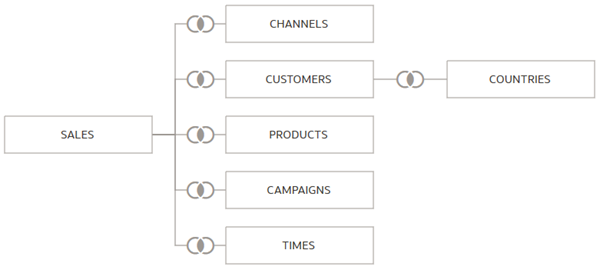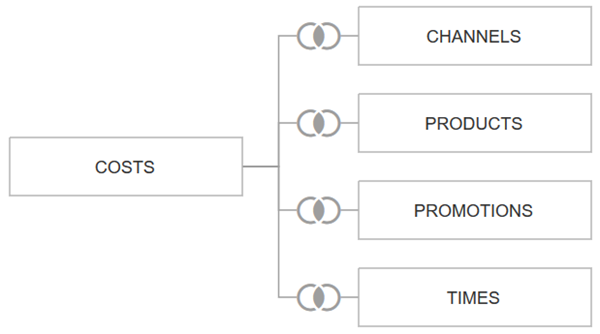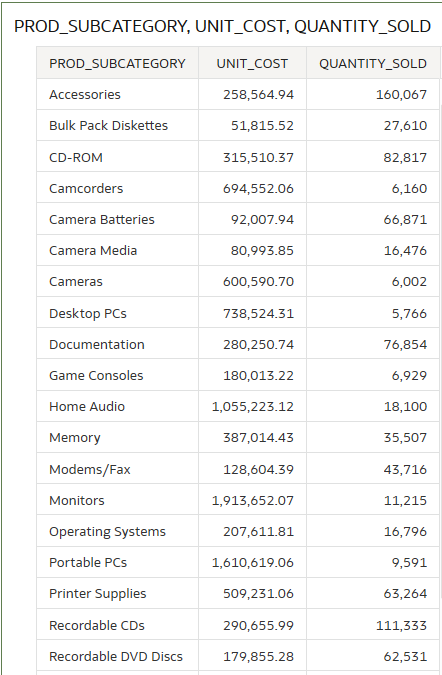Before You Begin
This 10-minute tutorial shows you how to duplicate a multiple table dataset to create a new dataset, apply changes to the dataset, blend two multiple table datasets, and then visualize the data.
Background
In this tutorial, you start with the Sales_History multiple table dataset, duplicate it, remove and add tables, and save the dataset with a new name, COSTS. You create a project with the COSTS datasets, add the Sales_History dataset to the project, and then to analyze the data.
This is the second tutorial in the Prepare and Analyze Datasets series in Oracle Analytics. Read the tutorials in the order listed.
- Create a Dataset with Multiple Tables
- Blend Datasets with Multiple Tables
What Do You Need?
- Access to Oracle Analytics
- Ability to connect to a relational data source such as Oracle Autonomous Data Warehouse or Oracle Database
- Access to the Sales_History dataset
Duplicate the Sales_History Dataset
- Sign in to Oracle Analytics.
- On the Home page, select the Sales_History dataset, click Actions, and then select Duplicate.
- Select Sales History-Copy, click Actions
 , and then select Inspect.
, and then select Inspect. - In Name, enter
COSTSto replace Sales_History-Copy, click Save, and then click Close. - On the Home page, select the COSTS dataset, click Actions
 , and then select Open.
, and then select Open.
Description of the illustration sales_history_costs.png - In the Join Diagram, hover over the following tables, and then click the X to delete each table:
- SALES
- CAMPAIGNS
- CUSTOMERS
- COUNTRIES
- In the Connections panel, expand the SH schema, hold down the Ctrl key, select the COSTS and PROMOTIONS tables, and then drag them to the Join Diagram.
- In the Join Diagram, drag the tables to the COSTS table to create joins.
Your dataset should look similar. You can move the tables to appear in a different order in the Join Diagram.

Description of the illustration costs_data_set.png - Click Save
 .
.
Blend the Datasets
- In the COSTS dataset, click Create Workbook.
- In the Visualize page, click Add
 , and then click Add Dataset.
, and then click Add Dataset. - In Add Dataset, click Sales_History, and then click Add to Workbook.
- Click Data to see the joins between the datasets.

Description of the illustration blended_data_sets.png - Click the number on the line between the datasets to edit the joins.
- In Blend Data, click the X in the CHANNEL_DESC row to remove this match.
- Click Both in the question about which dataset to delete the conformance, and then click OK.
The number on the match line represents the number of matches between the datasets. Reducing the number of matches between the dataset could improve performance during queries.

Description of the illustration edited_joins.png
Analyze the Data
- Click Visualize.
- In the Data panel, under the COSTS dataset, expand the PRODUCTS and COSTS tables. Under the Sales_History dataset, expand SALES.
- Hold down the Ctrl key, and select the following:
- PROD_SUBCATEGORY from PRODUCTS under the COSTS dataset
- UNIT_COST from COSTS under the COSTS dataset
- QUANTITY_SOLD from SALES under the Sales_History dataset
- Right-click, select Pick Visualization, and then select Table.

Description of the illustration prod_unit_cost_qnty_sold.png - In the visualization, click the Menu
 , select Edit, and then select Duplicate Visualization.
, select Edit, and then select Duplicate Visualization. - Select AMOUNT_SOLD from SALES under the Sales_History dataset, drag it to Rows to replace QUANTITY_SOLD.

Description of the illustration two_vizs.png
Learn More
Blend Datasets in Oracle Analytics
F38746-05
March 2025
Learn how to blend, join, and visualize datasets containing multiple tables in Oracle Analytics.
This software and related documentation are provided under a license agreement containing restrictions on use and disclosure and are protected by intellectual property laws. Except as expressly permitted in your license agreement or allowed by law, you may not use, copy, reproduce, translate, broadcast, modify, license, transmit, distribute, exhibit, perform, publish, or display any part, in any form, or by any means. Reverse engineering, disassembly, or decompilation of this software, unless required by law for interoperability, is prohibited.
If this is software or related documentation that is delivered to the U.S. Government or anyone licensing it on behalf of the U.S. Government, then the following notice is applicable:
U.S. GOVERNMENT END USERS: Oracle programs (including any operating system, integrated software, any programs embedded, installed or activated on delivered hardware, and modifications of such programs) and Oracle computer documentation or other Oracle data delivered to or accessed by U.S. Government end users are "commercial computer software" or "commercial computer software documentation" pursuant to the applicable Federal Acquisition Regulation and agency-specific supplemental regulations. As such, the use, reproduction, duplication, release, display, disclosure, modification, preparation of derivative works, and/or adaptation of i) Oracle programs (including any operating system, integrated software, any programs embedded, installed or activated on delivered hardware, and modifications of such programs), ii) Oracle computer documentation and/or iii) other Oracle data, is subject to the rights and limitations specified in the license contained in the applicable contract. The terms governing the U.S. Government's use of Oracle cloud services are defined by the applicable contract for such services. No other rights are granted to the U.S. Government.
This software or hardware is developed for general use in a variety of information management applications. It is not developed or intended for use in any inherently dangerous applications, including applications that may create a risk of personal injury. If you use this software or hardware in dangerous applications, then you shall be responsible to take all appropriate fail-safe, backup, redundancy, and other measures to ensure its safe use. Oracle Corporation and its affiliates disclaim any liability for any damages caused by use of this software or hardware in dangerous applications.
Oracle and Java are registered trademarks of Oracle and/or its affiliates. Other names may be trademarks of their respective owners.
Intel and Intel Inside are trademarks or registered trademarks of Intel Corporation. All SPARC trademarks are used under license and are trademarks or registered trademarks of SPARC International, Inc. AMD, Epyc, and the AMD logo are trademarks or registered trademarks of Advanced Micro Devices. UNIX is a registered trademark of The Open Group.
This software or hardware and documentation may provide access to or information about content, products, and services from third parties. Oracle Corporation and its affiliates are not responsible for and expressly disclaim all warranties of any kind with respect to third-party content, products, and services unless otherwise set forth in an applicable agreement between you and Oracle. Oracle Corporation and its affiliates will not be responsible for any loss, costs, or damages incurred due to your access to or use of third-party content, products, or services, except as set forth in an applicable agreement between you and Oracle.